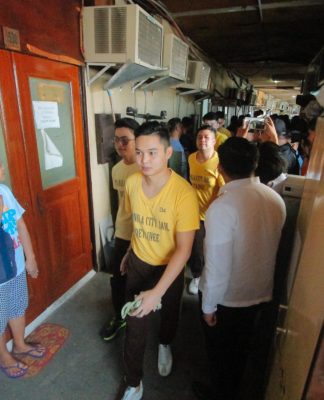BEYOND the walls of the University, danger prevails.
Crime incidence continued to increase in the university belt area (U-Belt) in the last quarter of the year, data from the University Belt Area (UBA) police station showed.
“This year, one university in U-belt recorded two cases: homicide and murder,” said Police Officer Shirley Inclan of Manila Police District Station 4 in Sampaloc.
Inclan was referring to the Oct. 2 incident wherein a former student of UST was stabbed inside the Far Eastern University (FEU) campus by a group of female students, while three members of FEU’s drum and bugle band were shot by unidentified motorcycle-riding gunmen last Dec. 4. Two of them were pronounced dead after being rushed to UST Hospital.
Moreover, a UST junior Pharmacy student was severely injured after being beaten and shot by a group of students at the corner of P. Noval and J. Barlin streets last Nov. 23.
“Although these cases are still under investigation, most of the time such kind of incidents are caused by fraternity wars,” Inclan said.
These incidents prompted National Capital Region Police Office chief Leonardo Espina to sack Precinct Commander Antonio Naag of UBA Police Station on P. Noval Street for “supposed operational lapses,” reports said.
UBA blotter entries for the last quarter of 2012 revealed that Lerma Street was the scene of most cases, with 19 incidents. The surrounding streets, which include S.H. Loyola Street and Claro M. Recto Avenue, recorded 12 and six cases, respectively.
España Boulevard came in with 18 and P. Noval Street with 15 reported incidents. Lacson Avenue recorded nine while Dapitan Street had eight occurrences.
Yuletide, elections blamed
Theft was the most rampant case in the U-belt with an average of three reports per day, Inclan said.
“Minors are usually the suspects of snatching incidents, but there’s a law prohibiting them from detention so we turn them over to the DSWD (Department of Social Welfare and Development) instead,” she said.
Theft cases in the UBA have reached 43 since October, followed by robbery with 38 reported incidents.
Cases of the modus operandi “salisi” numbered 26, most of them occurring on Bustillos and M. Earnshaw streets near España. The number of salisi crimes increased significantly from seven incidents in October to 13 in November.
Inclan cited the Christmas season and the upcoming elections as factors that led to the surge in crime volume in the Sampaloc area.
“While the crime volume surges, our follow-up operations likewise increase so we are able to find ways to solve them eventually,” she said.
Crimes usually occur at España Boulevard and Morayta during rush hours, from 4 p.m. to 10 p.m., Inclan said.
Physical injuries and threats, meanwhile, remained rampant in the residential areas of Sampaloc.
Cases of threats were higher in November with 17 reported cases, while October and December posted seven and five cases, respectively.
Reports of physical injuries, however, decreased from 10 in October to six in November and one in December. There were also reported cases of car theft, assault, alarm and scandal, and rape.
Two cases of theft at the UST multi-deck carpark building were recorded in the past two months, reports showed.
Inclan advised students to take responsibility for their actions when outside campus premises.
“Students must go home right after school and they should keep away from places which they know are dangerous,” she said. “At kung maglalakad kayo, parating may kasama. At huwag masyado mahilig sa mga gimik-gimik.” Nikka Lavinia G. Valenzuela and Cez Mariela Teresa G. Verzosa














